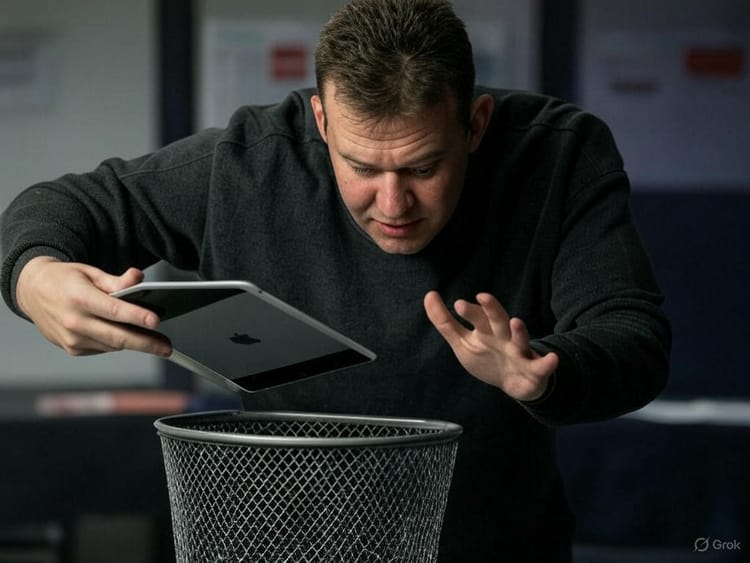E Poll Pads: The Trojan Horse of Elections?

Why are the MNSOS, multiple attorneys, and county level auditors and election managers so desperate to have these iPads, while answering very few tough questions about the software embedded in them?
In late 2024 I was put on hold for about five minutes at the Office of the Secretary of State (OSS) for asking a simple question about electronic poll pads, only to be transferred to someone who then deferred me to yet another person who did not answer the phone and did not call me back.
My recent look into Hennepin County's KNOWiNK contracts stalled when it was relayed to me that the "No responsive data" was returned because the Hennepin County Attorney was included on the emails I'd requested between KNOWiNK, OSS, and Hennepin County, allowing attorney-client privilege to block public access.
I do not know anyone who has reviewed the KNOWiNK source code, nor am I likely to find somebody who has, given that KNOWiNK is a non-governmental organization (NGO), a 3rd-party vendor. Despite the integral nature of their hardware and software to local, state, and nationwide elections, and despite the fact that KNOWiNK's iPads are either wi-fi connected or cellular connected (still internet), and are therefore vulnerable to remote access, the Elections Assistance Commission is not required to certify the equipment or software in order for it to be fit for elections in Minnesota—the Minnesota Secretary of State determines that.
My suspicion of electronics, computers, and many things digital dates from my days working for a Fortune 50 in Minneapolis. I had landed in this particular area of the company by mentioning to the hiring manager the development of an iOS app (for iPhone and iPad) that a small team and I designed and implemented in 2013. My job was primarily as a liaison between several business departments and the IT department, at the time when the company experienced a well-publicized data and security breach where hackers gained remote access to Target's servers: the hackers exploited first the HVAC system and then slipped executable files through a web portal which granted them remote access, eventually compromising data of 70 million customers, including 40 million credit cards.
The Cost of Secrecy
I am not the only one suspicious of these KNOWiNK devices.
Minnesota's first rollout of the KNOWiNK electronic poll pads occurred in Hennepin County in 2016, where the Mayor of St. Bonifacius, during the product presentation, within mere minutes hacked the system and didn't like the contract (which said if harmful code was embedded, then the county would not be liable), and his council voted not to use the iPads, leading to him being threatened with a lawsuit (which did not deter the council); St. Bonifacius became the only municipality of more than 40 in Hennepin, Minnesota's largest county by population to use pen and paper to check in voters on election day.
By 2018, much of Minnesota quietly received the KNOWiNK iPads and embedded software, except for those areas with poor internet service.
The bigger question, though, might be less related to the fact of internet connection than what exactly such a connection might enable, even if the hardware or software worked as designed on election day without any security breaches.
On this path of thinking, it is to be noted that the widespread readiness of these electronic poll pads was just in time for a significant 2018 midterms and the nationwide presidential election two years later. In 2020, the availability of the electronic poll pads coincided with, in Minnesota, the unconstitutional route taken through LaRose v. Simon and NAACP v. Simon (Simon fully participating) to waive absentee mail-in vote witness signature requirements AND extend the acceptance deadline.
At 3:57pm on election day, 2020, the Minnesota Attorney General tweeted that 'we don't have all the votes we need quite yet' and went on to recommend people get their friends go vote. It is conceivable that, combined with the already-collected absentee voting data from the 46-day absentee period, that the real-time access on election day itself—through the electronic poll pads acting as eyes and ears—provided Ellison information prompting him to post a tweet, which in turn may have activated certain levers such as additional absentee ballot dropoffs to later be reconciled with voters who had not voted, although this reconciliation took considerable time...
The biggest fact about Minnesota elections from 2020, that never became a headline, from any outlets, was that there were 700,000 MORE votes than voters on November 29, 2020, according the Statewide Voter Registration System (SVRS), which is managed by the Minnesota Secretary of State Steve Simon, five days after he and the other four members of the MN State Canvassing Board looked past this glaring fact to certify the election anyway. I myself did not learn this until attending a presentation first from Rick Weible (in 2021) and then from him and Susan Shogren Smith (in February 2022), in my mind the ONLY attorney in Minnesota to truly and fully stand with the people demanding transparency in government-administrated elections as documented by the petition to stop the 2020 certification on account of the missing voters and other irregularities, which was never heard by the Minnesota Supreme Court based on their dismissing it using a lame procedural tactic.
Reviving Suppressed Technology: Pen and Paper
The lack of transparency, including deliberate obfuscation in certain cases, are instances of irregularities that arouse yet further doubt in the officially stated purpose for having these devices, which is merely primarily to check in voters.
In a January 22, 2025 letter to cities considering e-poll pads, Rick Weible, the mayor who successfully defended his city's voters from the initial release of KNOWiNK in 2016, wrote: "You should know what you are signing up for, remember paper poll books cannot be hacked remotely since they for sure cannot be connected to a Wi-Fi, internet, or any network."
More recently, two (2) cities in Anoka County, Oak Grove and Ramsey, have cancelled their contracts, and now election managers, county attorneys, and the MNSOS are arguing that those cities are somehow still required to use them, seemingly ignoring Minn Stat §201.225 which refers to authorization in subdivision 1 and the revoking of usage in subdivision 6. If there is no choice for cities (or indeed counties), then the 95th Minnesota Legislature should clarify, just as the 93th Minnesota Legislature clarified unconstitutionally to require the usage of electronic tabulators for those precincts that previously used them (unconstitutional by ex-post facto). (Then, in 2024, the 94th Minnesota Legislature made it extremely difficult to hand count by inserting language that ballots must be sealed immediately after the close of polls.)
At the end of the day its an iPad with cellular service and 3rd-party software. How is that ever going to be more secure than paper at the local precinct? —Derek Lind, Ramsey
Anoka County commissioners are considering buying yet another batch of iPads from KNOWiNK on February 25, 2025, despite many good reasons NOT to (video: Ramsey), while other counties that don't yet use them, like Isanti, are also being offered the hardware and software.
One wonders whether paper and pen are being equally considered.
Erik van Mechelen, 2022 candidate for MN Secretary of State, is a writer interested in removing government corruption, alerting the public to "evil by design", and redistributing suppressed technologies like pen and paper (for elections) and zero point energy (for all humanity).




Member discussion